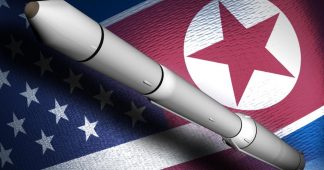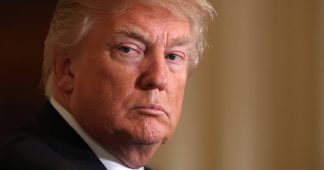Tense standoff continues on Korean peninsula
By Peter Symonds
The confrontation on the Korean Peninsula is continuing as the US threatens military action against North Korea unless it moves to dismantle its nuclear and ballistic missile programs. The American and international media is compounding tensions with speculation that Pyongyang could conduct a nuclear or missile test to mark its Military Foundation Day on Tuesday.
The nuclear aircraft carrier, the USS Carl Vinson, and its strike group of guided missile destroyers and cruisers are due to arrive in nearby waters on the same day. According to the Korea Herald, the aircraft carrier strike group will join the South Korean navy in a “massive maritime drill.”
The US and South Korean militaries have been engaged in huge joint war games that began in March and are due to continue until the end of April. The basis for these exercises shifted in 2015 from nominally defensive to “pre-emptive” under Oplan 5015, which reportedly includes sabotage inside North Korea and “decapitation” raids to kill North Korean leaders.
South Korea’s Unification Ministry spokesman Lee Duk-haeng indicated that US and South Korean forces were on heightened alert. “We are closely watching the situation and will not be letting our guards down,” he said.
Lee pointed to the very tense standoff on the Korean peninsula “where a lot of exercise equipment is amassed in North Korea and also a lot of strategic assets are situated on the Korean peninsula because of the South Korea-US military drills.”
The US is applying a great deal of pressure on Beijing to compel Pyongyang to bow to Washington’s demands. Trump told a press conference on Thursday he was confident that Chinese President Xi Jinping would “try very hard” to rein in North Korea and referred to “some very unusual moves” that Xi had made in the previous few hours. Trump provided no details.
A senior Trump administration official told CNN: “Nobody thinks the Chinese are going to press North Korea militarily or bring the regime to its knees, but the strategy looks to China to find a political solution more than anything else.” The White House is pushing Beijing to exploit Pyongyang’s dependence on trade with China, including for food and oil, to bully it into submission.
At the same time, China is reportedly preparing for possible conflict. A US official told CNN the Chinese air force appeared to have put land-attack, cruise-missile-capable bombers “on high alert” on Wednesday. The official said the US has also seen an extraordinary number of Chinese military aircraft being brought up to full readiness through intensified maintenance. Unsubstantiated reports earlier this month indicated that the Chinese military had moved 150,000 troops to the border with North Korea.
In Russia, a Kremlin spokesman refused to comment on media reports based on observations by local residents that its military was moving hardware and troops toward Russia’s own border with North Korea.
The Trump administration is continuing to ramp up diplomatic pressure on North Korea, pushing through a resolution in the UN Security Council on Thursday condemning its latest failed missile test last weekend. The US conceded to Russian demands to include a cosmetic reference to the need for “dialogue” with North Korea. At the same time, the resolution threatened “further significant measures”—a threat of more crippling sanctions.
US Vice President Mike Pence arrived in Australia last night on the final leg of his Asian trip that also included South Korea and Japan. He has used the trip for discussions with Washington’s chief allies in Asia and to issue menacing warnings to North Korea that “all options are on the table”—that is, including pre-emptive military attacks.
After meeting with Pence on Tuesday, Japanese Prime Minister Shinzo Abe pledged his government’s support for the US administration’s threats against North Korea. He declared that “dialogue for the sake of dialogue is valueless,” adding, “It is necessary for us to exercise pressure on North Korea so that it comes forward and engages in this serious dialogue.”
The Asahi Shimbun reported Japanese preparations for the mass evacuation of Japanese nationals from South Korea in the event of conflict. According to government officials, Tokyo was considering bringing citizens home on US as well as Japanese military aircraft and vessels.
Top officials on North Korea from the US, South Korea and Japan are due to meet in Tokyo on Tuesday. According to South Korea’s foreign ministry, the meeting will “discuss plans to rein in North Korea’s additional high-strength provocations, to maximize pressure on the North, and to ensure China’s constructive role in resolving the North Korea nuclear issue.”
This weekend, a highly secretive meeting of the heads of the intelligence agencies from the “Five Eyes” network, comprising the US, Britain, Canada, Australia and New Zealand, is due to take place in New Zealand. While no details have been released, the gathering is taking place under conditions of heightened geo-political tensions and will undoubtedly discuss North Korea.
In parallel with the Trump administration’s threats against North Korea, the US and international media continue an endless stream of propaganda denouncing Pyongyang as a “rogue regime” and openly debating the pros and cons of various forms of military action in a bid to condition public opinion.
A chilling article in the Washington Post entitled “Twenty-five million reasons the US hasn’t struck North Korea” outlined the consequences for the 25 million residents of the South Korean capital of Seoul in the event of war with North Korea. Even if nuclear weapons were not used, North Korea has large numbers of long-range artillery pieces and rocket launchers that would have a devastating effect.
A 2012 Nautilus Institute study estimated that North Korean artillery would be able to fire about 4,000 rounds an hour into the Seoul area, killing over 2,800 people in the first volley and 64,000 on the first day, the majority in the first three hours. Some of the casualties would be American because the US military has personnel stationed on bases close to the Demilitarised Zone between the two Koreas.
The Washington Post suggested the massive death toll as a reason why the Trump administration would not launch a military attack on North Korea. However, there is no reason to believe that the White House would pull back from war. Trump officials have repeatedly declared that “all options are on the table” and the US would “solve North Korea” alone if China failed to do so.
The result would be a devastating conflict that would not be confined to the Korean peninsula and could draw in other nuclear-armed powers such as China and Russia.
Read also
Chinese Nuclear Forces on High Alert
US Ex-Secretary of Defense Panetta: Trump is Risking Nuclear War
Ex-CIA chief says Trump’s Actions Escalate Crisis with Korea











